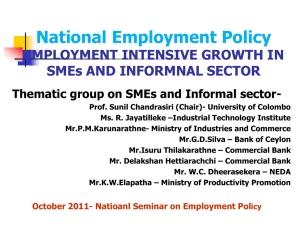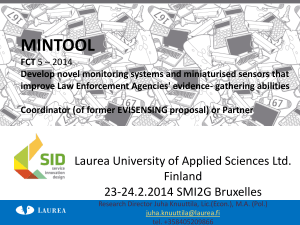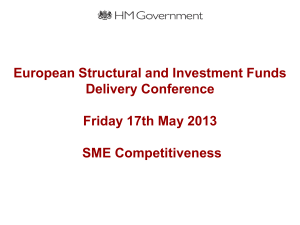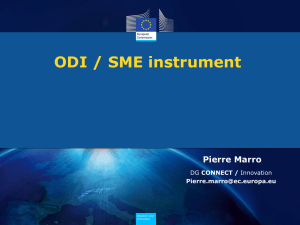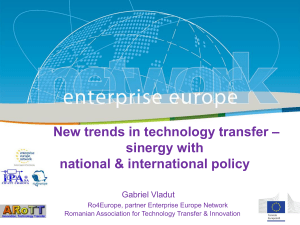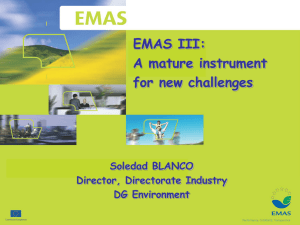Green SME - We-een
advertisement
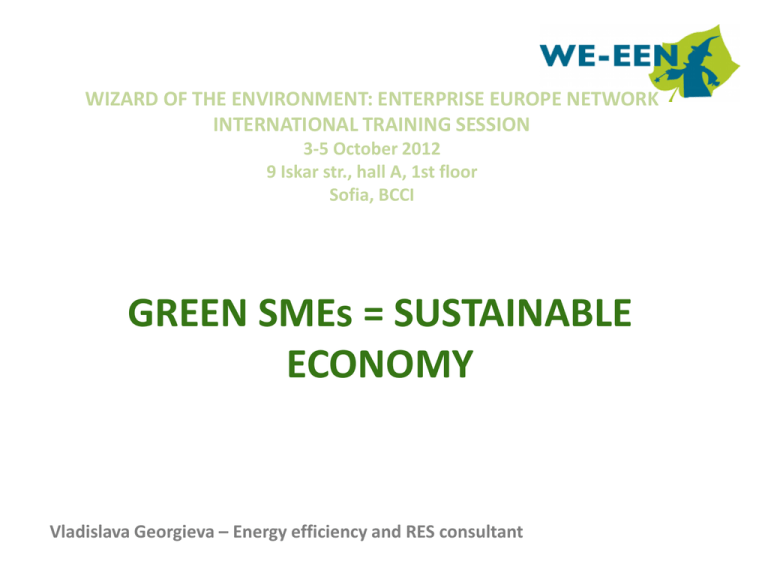
WIZARD OF THE ENVIRONMENT: ENTERPRISE EUROPE NETWORK INTERNATIONAL TRAINING SESSION 3-5 October 2012 9 Iskar str., hall A, 1st floor Sofia, BCCI GREEN SMEs = SUSTAINABLE ECONOMY Vladislava Georgieva – Energy efficiency and RES consultant The problem: The main problem is that the EU's 20% policy objectives for energy savings could not be met with present policies - thus the related environmental, social, security of supply and economic benefits could not be realized. Action The main questions: • Will SMEs be able to contribute to EU’s 20% policy objectives? • What is SMEs’ role? • Will SMEs be able to play a key role in delivering Green services, deals and knowledge? • Do they know “WHAT, HOW, WHY”? EU STRATEGIC PRIORITIES Smart growth: developing an economy, based on knowledge and Innovation Sustainable growth: promoting more resourceefficient, greener and more competitive economy Inclusive growth: fostering high-employment Economy. delivering social and territorial cohesion. Why SMEs? • In the European Union there are more than 20 million enterprises in the private sector – of these 99% are small and medium-sized enterprises (SMEs) with a workforce of nearly 90 million people. • In general 60% -70% of the environmental impact is related to SMEs. Why SMEs? • SMEs contribute 64% of environmental impact • About 24% of SMEs are actively engaged in actions which are reducing their environmental impact • About 0.4% of SMEs use a certified Environmental Management System • Most EU businesses are small and mediumsized enterprises (SMEs). They represent an enormous energy saving potential for the EU Why SMEs? While the environmental impact /including energy consumption/ from an individual company may be low, the overall impact of a sector can be very high. Small & Medium Enterprises Facts and figures Statistical trends since 2003 clearly demonstrate vigorous development of Bulgaria’s SME sector in recent years. The growth in the number of Bulgarian enterprises was only temporarily dampened by the crisis, with growth levels picking up again relatively quickly. This development was particularly driven by small and medium sized enterprises. Small & Medium Enterprises Facts and figures Small Business Act profile for Bulgaria is behind the EU average. The figures show that Bulgaria is performing in line with its EU peers on four of the eight SBA principles for which averages are available for Bulgaria (the area average for principle 9 ‘Environment’ is missing for all countries owing to lack of data, and for the SBA area ‘Think Small First’, here is only one indicator available for Bulgaria), namely Responsive administration, Public procurement and state aid, Access to finance and the Single market. For the remaining four principles, Bulgaria is behind the European average. Small & Medium Enterprises fact sheet • There are more than 352 000 SMEs in Bulgaria and large share of them are micro enterprises. • The realized SMEs activity revenues amount at BGN 136 112 mn, and a decrease of 1.4% with respect to the previous year is registered. • The SMEs employed 73% of total country workforce. • The Bulgarian SMEs are one of the SMEs with smallest turnover in Europe. • In 2011, the most utilized financing source in Bulgarian SMEs are the funds of the owner (62%). Small & Medium Enterprises fact sheet • At the beginning of 2012, the access to financing is severely restricted for 69% of the enterprises. • Over a half of the SMEs are afraid of bankruptcy (54%). • 86% of the SMEs do not have sufficient financial resources to finance the necessary investments. • The most frequently encountered innovative activity in the Bulgarian SMEs is related to amendments in the business processes targeted at optimization and cost cutting (38%). • The least penetrated innovative activity is related to carrying out mutual initiatives in the area of education between the individual enterprise and the academic institutions (9%). • In 57% of the SMEs low innovation activity is observed, and in 8% of them it is relatively high. SME and environmental issues – quick fact sheet • Very small SMEs’ share completely complied with the EU requirements and most are not prepared to fulfill the quality, environmental, safety and other EU requirements. • SMEs are aware of main environmental impact associated with their activities, but the level of awareness of EU environmental legislation is considerably low. • The graph below is presenting data about Requirements Acquire Level SME and environmental issues – quick fact sheet SME and environmental issues – quick fact sheet • SMEs are aware of environment protection legislation field concerning activities and in particular of the most typical requirements related to the energy efficiency measures and air polluting emissions. • Usually SMEs complied with environmental legislation driven by obligations/penalties (refer to their operation) and in same case because of dement requirements (certificate ISO9001 and ISO14001). • In contrast environmental activities as reduction of energy consumption and/or introduction of energy standards are implemented because of possible expenses reduction and some funds availability (special credit line and EU funds). SME and environmental issues – quick fact sheet • ISO 9001 • 3818 certified companies /total/ • 237 certified companies /metal and metal product sector/ • ISO 14 001 • 898 certified companies /total/ • 63 certified companies /metal and metal product sector/ • Only 14% of SME’s meet all environmentally related requirements, but at the same time 73% of all Bulgarian companies are not making any environmental investments. SME and environmental issues – quick fact sheet Nevertheless, number of environmental impact initiatives are already indentified and applied as: • Best available technology • Clean Technologies – environmental friendly machines, equipment and systems; systematic technical service and maintenance • Energy Management System and RES utilization • Eco-labeling • Eco-design Outline obstacles and how to overcome it Lack of awareness and access to appropriate information Web based tools development, training, experts’ on-site visiting and advising, networking, help-desk etc. Lack of financial resources and incentives The SMEs are facing serious difficulties in Certification and Standardization because of additional cost load – development and introduction of special funds or grand schemas for SMEs with clear and simplified application procedures, fiscal tools. Clumsy administrative procedures Procedures simplification and establishing better environment and communication between SMEs and responsible authorities. Heavy and prolonged procedures for EMAS, ISO 14001, REACH and other standards’ introduction. A new Directive on Energy Efficiency Challenges addressed & solutions proposed MEETING ALL THREE “20-20-20 BY 2020” GOALS BECOMES A MATTER OF URGENCY A new Directive on Energy Efficiency Challenges addressed & solutions proposed So far the EU is not on track to meet its 20% energy efficiency target A new policy proposal in relation with SMEs How SMEs could become green and sustainable? How SMEs could become green and sustainable? EMAS – eco management and audit schema The EU Eco-Management and Audit Scheme (EMAS) is a management tool for companies and other organisations to evaluate, report and improve their environmental performance. The scheme has been available for participation by companies since 1995 and was originally restricted to companies in industrial sectors. Since 2001 EMAS has been open to all economic sectors including public and private services. The new EMAS scheme makes it easier for SMEs to participate. With the introduction of EMAS III, environmental audits, covering all activities at the organisation concerned, must be conducted within an audit cycle of no longer than three years. Additional information on: http://ec.europa.eu/environment/emas/toolkit/index.htm How SMEs could become green and sustainable? ECAP – Environmental Compliance Assistance Programme The European Commission proposed an Environmental Compliance Assistance Programme to make it easier for SMEs to comply with their obligations and improve their environmental performances. There are a number of areas where action is being taken: • Minimising the administrative burden on companies • Helping SMEs integrate environmental concerns into their businesses • Supporting regional and national networks • Building up local know-how • Improving communication • Providing funding Additional information on: http://ec.europa.eu/environment/sme/programme/programme_en.htm How SMEs could become green and sustainable? ISO 14001 – Environmental management systems The ISO 14000 family addresses various aspects of environmental management. It provides practical tools for companies and organizations looking to identify and control their environmental impact and constantly improve their environmental performance. ISO 14001:2004 and ISO 14004:2004 focus on environmental management systems. The other standards in the family focus on specific environmental aspects such as life cycle analysis, communication and auditing. ISO 14001:2004 and SMEs Small and medium sized enterprises (SMEs) also benefit from ISO 14001:2004. However, implementing an environmental management system in SMEs can be challenging. The publication of ISO 14001, Environmental Management Systems - An easy to use checklist for small business, will help SMEs to achieve the benefits of implementing an environmental management system based on ISO 14001. Additional information on: http://www.iso.org/iso/home/standards.htm How SMEs could become green and sustainable? ISO 50001 – Energy management ISO 50001:2011 specifies requirements for establishing, implementing, maintaining and improving an energy management system, whose purpose is to enable the organization to follow a systematic approach in achieving continual improvement of energy performance, including energy efficiency, energy use and consumption. ISO 50001:2011 has been designed to be used independently, but it can be aligned or integrated with other management systems. ISO 50001:2011 provides a framework of requirements for organizations to: • Develop a policy for more efficient use of energy • Fix targets and objectives to meet the policy • Use data to better understand and make decisions about energy use • Measure the results • Review how well the policy works, and • Continually improve energy management. Additional information on: http://www.iso.org/iso/catalogue_detail?csnumber=51297 How SMEs could become green and sustainable? Energy efficiency certification / energy audit Since January 2009, EU Member States have been required to effectively comply with the Energy Performance of Buildings Directive (EPBD). One of the requirements set by the EPBD is to introduce Energy Performance Certificates (EPCs) which are required to be issued when a building is constructed, sold or let, i.e. as a part of a property transaction. As defined by the EPBD, the Energy Performance Certificate is a document recognised by a Member State or by a legal person designated by it, which indicates the energy performance of a building or building unit, calculated according to a methodology adopted in accordance with Article 3. Additional information on: http://ec.europa.eu/energy/efficiency/index_en.htm How SMEs could become green and sustainable? Energy efficiency certification / energy audit Energy Efficiency Audit. Understanding energy use will help to identify opportunities to improve energy performance and gain financial benefits. The audit will establish a baseline and provide options for improving energy efficiency. Make a Commitment. No matter the size or type of an organization, the common element of successful energy savings is commitment. Make a commitment to allocate staff and funding to achieve improvement. Set Goals. Well-stated goals guide daily decision-making and are the basis for tracking and measuring progress. Communicating and posting goals can motivate staff to support energy management efforts. Develop a plan. Your organization is now poised to develop a road map to improve energy performance. Create a detailed action plan to ensure a systematic process to implement energy performance measures. Implement the plan. People can make or break an energy program. Gaining the support of key people at different levels within the organization is an important factor in successful implementation. In addition, reaching your goals frequently depends on the awareness, commitment, and capability of the people who implement the projects. Thank you for your attention! Vladislava Georgieva + 359887283723 E-mail: vladislava.georgieva@asde-bg.org




